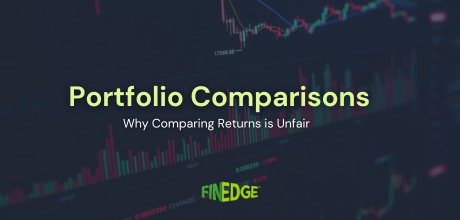Why SIP's are the Best Way to Invest into Volatile Equity Markets

In this blog, discover how SIPs (Systematic Investment Plans) can help you navigate market volatility with ease. Learn how the strategy of Rupee Cost Averaging works to mitigate risks, and why staying invested for the long term is the key to wealth creation, even during market downturns.
Buy low and sell high
In principle, we’re all aware that that’s the way to make money in equity markets. Unfortunately – driven by our emotions, we more often than not end up buying more when markets are high (out of euphoria) and liquidating our investments when markets fall (out of fear).
The reason why SIP investing has been so successful in creating wealth for investors over the past decade is that by saving dispassionately in an SIP, an investor actually ends up automatically buying more units when markets fall and buying fewer units when markets go up (precisely the right way to invest in equity markets). This takes place through a mechanism called “Rupee Cost Averaging”.
What is Rupee Cost Averaging?
Rupee Cost Averaging is a wonderful risk mitigation mechanism exclusive to equity SIP’s. By investing a fixed sum of money every month, you ensure that the average buying price of your units is neatly averaged out, thereby providing you with stable growth over the long term.
How investors react to market cycles
Media frenzy surrounding stock markets often leads investors to take irrational decisions based on the twin ‘value destroyers’ - greed and fear.
For SIP investors, it’s vital to think long term and insulate yourself from views of stock market ‘pundits’. Business news channels need to sensationalize market movements, and this takes place at the expense of poor investors (who react to headlines such as ‘Bloodbath on Dalal Street’ with justifiable fear!)
Ironically, the same investor rushes in to start new SIP’s when the headlines read ‘Nifty scales all-time high or ‘Euphoria on Dalal street!’ Both approaches are wrong.
As a result of the above, a large number of SIP’s land up getting terminated during the final months of market lows - and resume during the final months of bullish cycles. Common sense dictates that this is the exact opposite of what should be done. As a wise man once said, ‘a little bit of knowledge is a dangerous thing’!
By letting emotions cloud their judgment, investors often lose out on the real benefits of SIP’s. They continuously stop and restart their SIP’s - when the optimal strategy would be to just let them continue and allow market cycles to take their course.
Investors who stopped their SIP’s and redeemed their money during the last market downturn (an astounding 16 Crore SIP accounts were closed in 2010-2011 in India!) lost out on the entire bullish cycle that commenced shortly thereafter.
Since one saves fixed sums of money in an SIP every month, the question of ‘timing the market’ shouldn’t arise. One must remain dispassionate towards market cycles when it comes to their SIP’s with the firm understanding that the magic of ‘rupee cost averaging’ is always at play.
Make volatility your friend!
In the past few months, global events (Greece, Iran, Oil, China and others) have contributed to significant volatility in the Indian markets. In fact, the Nifty has been down by around 5% over the past 6 months. As a long term SIP investor with a long term time horizon, should you worry? Definitely not! You should allow your SIP tranches to continue as always and allow larger unit balances to accrue during such downturns.
An Example
Let’s drive home the above point with a simple example using a popular Large Cap Equity Fund Franklin India Opportunities Fund. Most of us know about the carnage that took place during the crash of 2008, when the Nifty fell from 6300 levels all the way to sub-3000 levels in a space of 1.5 years! Let’s assume that you started your SIP at the peak of the market in January 2008 and continued dispassionately until today with a sum of Rs. 5000/ month. For the first SIP installment, you’d have received 123 units at an NAV of Rs. 40.7. As the fall picked up pace, you’d end up purchasing more and more units with your SIP instalment of Rs. 5000. In fact, by March 2009 the NAV had fallen to 15.7, giving you a massive 317 units for the same Rs. 5000 instalment!
Cutting a long story short – your post tax annualized returns from the SIP between 2008 and 2015 would be an impressive 17.49%, creating wealth of 9.02 Lacs for you from your small monthly SIP! That’s approximately twice the returns from a PPF account.
The Bottom Line
The key takeaway here is that dispassionate ‘savers’ always extract a lot more value from SIP’s than active traders. By committing yourself to riding the SIP wave for a long term horizon irrespective of market ups and downs, you’ll be stacking the odds heavily in your favor and setting yourself up for long term wealth creation.
Your Investing Experts
Relevant Articles
Why Comparing Investment Returns Can Be Misleading
At some point, most investors have compared their investment returns with a friend, a colleague, or a number they saw online and wondered why their outcomes looked different. While this instinct is natural, return comparisons are often incomplete and, in many cases, misleading. Understanding why returns differ is far more important than comparing the numbers themselves.
CAGR vs XIRR vs Absolute Return: Understanding Which Return Really Matters
When reviewing investment performance, investors often come across multiple return figures absolute return, CAGR, and XIRR. While these numbers may appear similar, they measure performance very differently. Understanding what each metric represents, and when to use it, is essential for making informed investment decisions and setting realistic expectations.
Responsible Credit Card Usage: Three Principles Every Consumer Should Follow
Credit cards are powerful financial tools when used correctly, offering convenience, rewards, and short-term liquidity. But when used without discipline, they can quickly turn into high-interest liabilities. Understanding a few essential principles can help you manage your cards responsibly, maintain a strong credit score, and avoid stress caused by compounding debt.
.png)

.png)
.png)